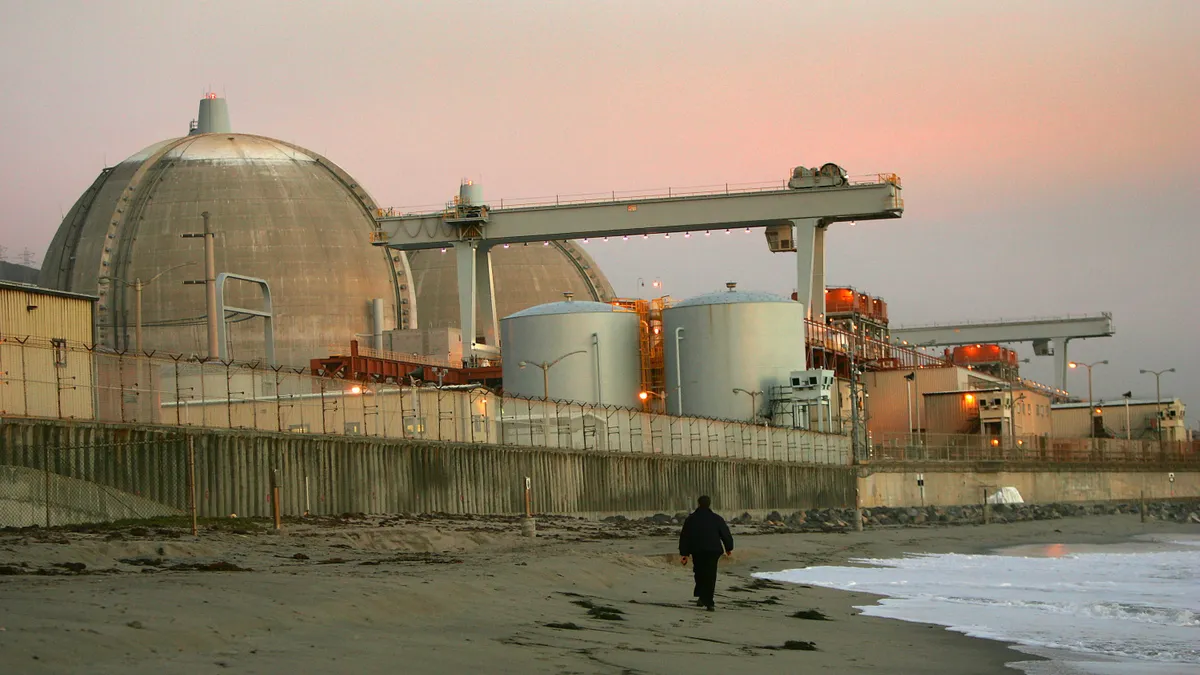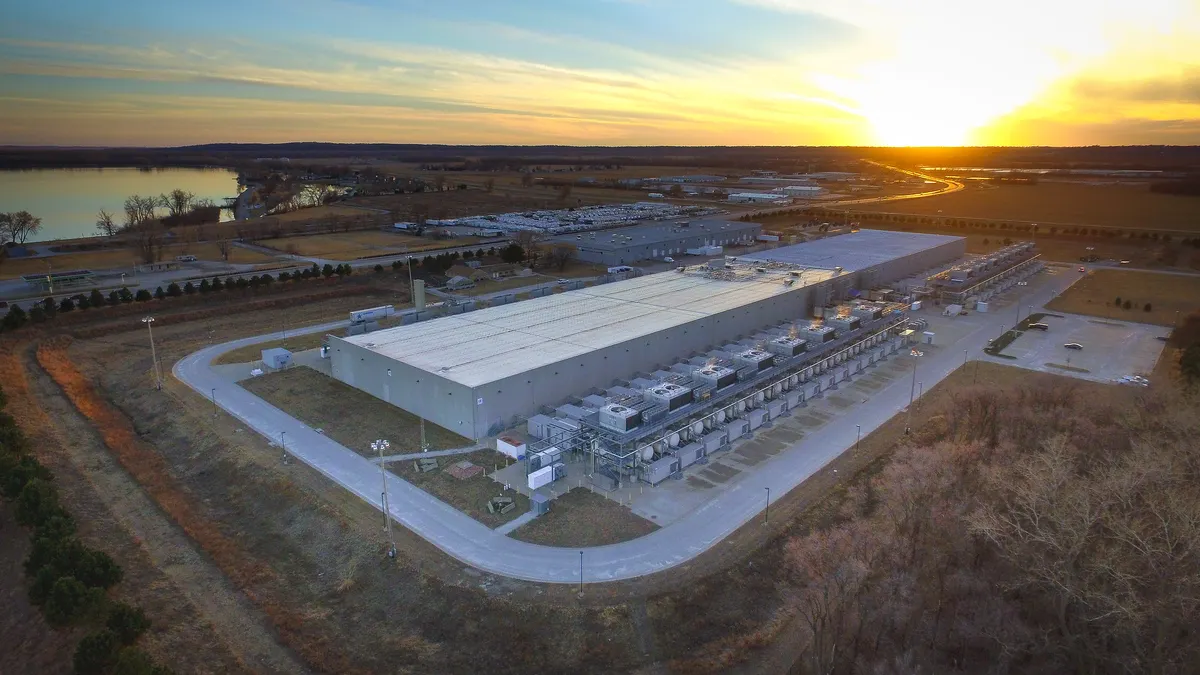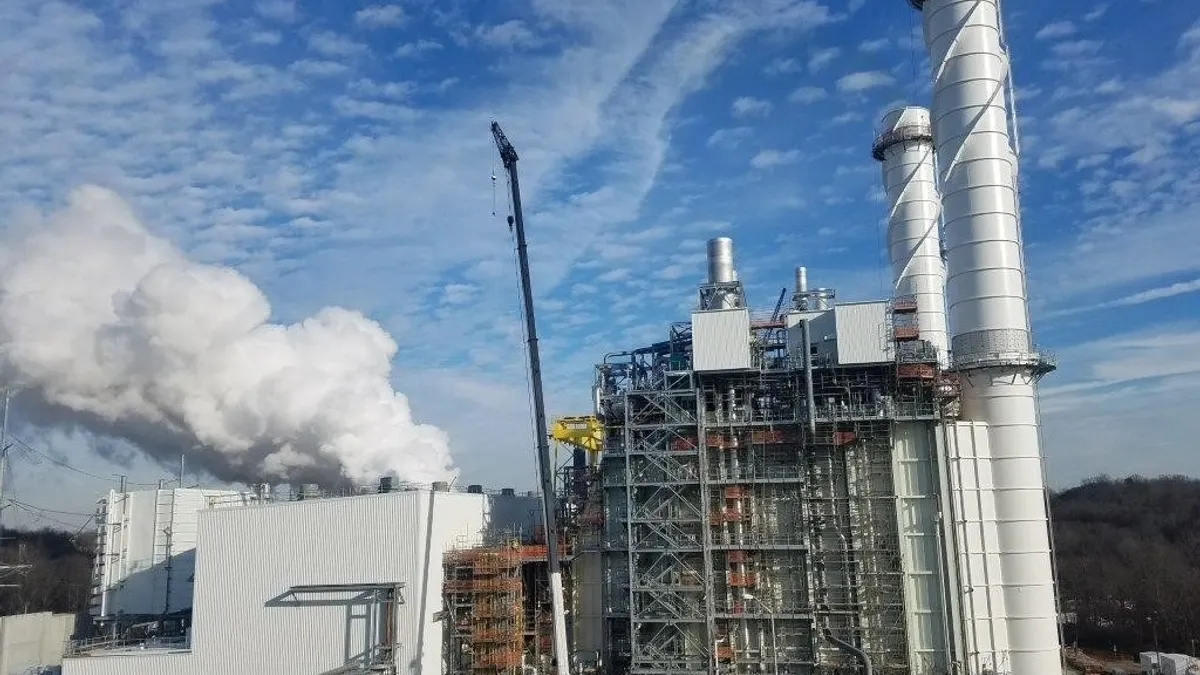The following is a contributed article by Amory B. Lovins, adjunct professor of civil and environmental engineering and scholar at the Precourt Institute for Energy, Stanford University.
A recent opinion piece in Utility Dive touting the merits of nuclear power favors a "technology-inclusive approach" over reliance "solely" on desirable-but-inadequate renewables. This framing avoids comparing technologies by claiming all are needed, and even makes comparisons sound unjustly discriminatory by echoing social-inclusion language. It condenses the exuberantly diverse renewable portfolio to "just one technology." It also omits the biggest, cheapest resource — energy efficiency. Yet the piece evades nuclear power's actual status, economics, prospects and operational role.
Nuclear power's one-tenth share of global electricity is stagnant and slipping. In 2020, nuclear power added 0.4 GW more capacity than it retired — 782 times less than renewables' 278 GW, equivalent to about 232 times less added annual output. In 2021, its capacity dropped for the seventh year in the past 13. The global fleet averages 32 years old, so retirements are outpacing additions. Nuclear culture, skills, vendors and prospects are shriveling — mostly due to bad economics. Sun and wind are now the cheapest bulk source for at least 91% of world electricity, says Bloomberg New Energy Finance (BNEF), so they're winning about 10–20 times more investment.
Claims of "competitive" foreign nuclear plants are cited to a 2016 report that was convincingly debunked—even by the opinion piece's own author. In fact, BNEF finds the cheapest reactors, in China, cost at least twice as much per kWh as the Chinese wind and solar that outgenerate them 2:1, so China's 2020 renewable investments at least matched the previous 12 years' cumulative nuclear investment decisions.
The "best analysis" behind the opinion piece's assertion that renewables plus nuclear "can create the most cost-effective carbon-free energy system" adds nuclear only if it's very cheap (assuming learning curves not observed for modern reactors, let alone for types of reactors that do not exist). It also assumes that renewables and storage are far costlier than BNEF’s empirical data show (unable to follow observed learning curves), and excludes most grid-flexibility resources. Diverse peer-reviewed studies without such artificial constraints — 56 of which were published by April 2021, then many more, e.g., here, here, here and here — better match empirical market choices and need no nuclear power to minimize cost or carbon.
Competing climate solutions
In over 24,000 actual market projects, new unsubsidized renewables make electricity 5–13 times cheaper than nuclear newbuild according to BNEF; merchant bank Lazard analysis finds 3–8 times. Per dollar, renewables therefore provide 3–13 times more kWh and can displace 3–13 times more fossil-fueled generation. Still-cheaper efficiency is even more climate-effective.
As my 2019 nuclear-and-climate analysis and its summaries here and here noted, grid integration costs matter too when comparing electrical resources — but not much. They'd need to be about 2–12 times renewables’ levelized cost of energy (LCOE) for nuclear to rival renewables, but the opposite is true. Solar and windpower integration costs are at worst comparable to their LCOE. In the U.K., these grid integration costs are modest, and U.S. utilities find they're manyfold below renewables' LCOE even at 85% wind share, so adding them into the comparison can't flip the outcome as the opinion piece claims. BNEF finds that even a flat load is now most cheaply by variable renewables, plus backup that's also carbon-free if it’s demand-side, renewable, or storage. That's why the International Energy Agency forecasts renewables to provide at least 95% of the world's new capacity, or around 305 GW/year, through 2026.
Moreover, including grid integration (or similarly small grid expansion) costs would probably increase nuclear's cost disadvantage, because big thermal plants typically incur severalfold higher integration costs than wind or solar farms, consistent with longstanding Lawrence Berkeley National Laboratory and National Renewable Energy Laboratory findings. That's because those renewables' outages are far smaller, slower, shorter and more predictable — often more predictable than demand itself. Renewables largely avoid big thermal plants' high intermittency (forced-outage) costs for reserve margin, spinning reserve and cycling. Those costs too must be counted and compared.
Adding "complementary" nuclear power doesn't help but harms variable renewables. Its cycling limitations and high capital cost require maximum runtime, but nearly-zero-operating-cost renewables idle reactors by dispatching whenever available. Reactors can't have both a high and a low capacity factor — pick one. Moreover, cycling reactors spoils their economics via lifetime, maintenance and efficiency penalties, and spreading high fixed costs over less output. The same holds true for proposed (but often rejected long ago) Small Modular Reactors, which bring greater economic and use-case challenges, novel safety and proliferation issues that are now making the Department of Energy undercut the mission of the Department of Defense, and lesser carbon savings achieved later.
Thus nuclear newbuild, already grossly uncompetitive when renewables generate a minor share, gets more so as they grow. It's also slower, so it cut global 2010–20 carbon emissions fivefold less than renewables did. As President Emmanuel Macron of France just said, "We need to massively develop renewable energies because it is the only way to meet our immediate electricity needs, since it takes 15 years to build a nuclear reactor."
Most existing reactors cost more just to operate than replacing them with similarly carbon-free efficiency and renewables. The opinion piece urges compounding that misallocation with billions more in subsidies to keep uneconomic reactors running and save carbon. But letting them exit the market instead would open up demand and grid capacity for cheaper carbon-free competitors to contest, saving more carbon starting a year or two later as efficiency and renewables overtake and reverse transient gas substitution.
Duct-taping new nuclear subsidies to more-popular renewables diverts more capital to less climate-effective nuclear projects, saving less carbon. And nuclear phaseouts work. In 2010–20, Japan, despite suppressing windpower, replaced with renewables and efficiency its entire lost 30%-nuclear output, displacing the 21 zombie reactors sidelined for the past 10–14 years. Germany (30% nuclear in 2000) meanwhile offset its nuclear closures with renewables and efficiency while slashing coal generation 64% and lignite 37%. It now plans to triple its pace of renewable expansion to get off fossil fuels even faster — and achieve even quicker efficiency gains to displace Russian gas "at Tesla speed."
Balancing a renewably powered grid
Decarbonization without "firm" generators looks "extremely costly" only if most grid-flexibility solutions are excluded. At least ten carbon-free methods (the International Renewable Energy Agency found 30) — not just the costliest one, giant batteries — can keep grids reliable as they become renewable. In rough order of increasing cost, they are:
- Electric end-use efficiency (or negawatts) could quadruple in the U.S. by 2050, costing a tenth today's average retail price. Lower energy intensity provided 77% of global 2014–16 decarbonization, cut 1975–2021 U.S. primary energy use 60%, and can do far more, especially with integrative design and rethinking supposedly "harder-to-abate" sectors. Not comparing or competing efficiency overbuys supply and complicates grid balancing.
- Flexible demand that shifts certain loads' timing without inconveniencing customers can exceed the demonstrated residential peak load savings. For example, eight kinds of "flexiwatts" could eliminate the Texas grid's steep evening load ramp as people come home and turn stuff on just as solar power fades — and could also cut nonrenewable capacity 24% and daily summer load range about 42%, make renewables 26% more valuable, and pay back in about five months. Competing such load-shaving and -shifting building-efficiency retrofits against electricity storage can eliminate most long-duration storage needs (small anyhow) in four key U.S. regions, cutting investment by at least an order of magnitude.
- More-accurate forecasting already makes East Danish windpower dispatchable in day-ahead hourly markets, just as offshore windpower is stabilizing the German grid.
- Renewable diversification by type and location captures valuable complementarity; just combining anticorrelated sites can double U.S. windbelt productivity.
- Dispatchable renewables — virtually all renewables except photovoltaics and wind (subject to #3) — and industrial cogeneration can directly balance PV and wind variations.
- Storing heat or coolth, even in existing buildings’ fabric, is a vast, low-cost grid-balancer, as NREL found.
- Behind-the-meter batteries (often cost-effective even in 2014) will soon be joined by terawatts of profitable storage opportunities in parked bidirectionally charging electric vehicles. Just EVs plus ice-storage air conditioning could enable 100% renewable power for ERCOT in 2050, with excellent economics and no bulk storage.
- Pumped storage worldwide totaled 158 GW in 2019 with another 53 GW under construction and 226 GW under consideration, plus compressed air, gravity, and other emergent non-chemical methods.
- Readily storable power-to-X "green molecules" (hydrogen or ammonia) can run fuel cells or existing gas plants in any desired quantity, and have reportedly reached $2.7/kgH2 in China.
- Grid-scale battery storage added 5.2 GW in 2020, rivaling gross nuclear build, then far outpaced it, with 358 GW / 1 TWh to be added by 2030. It's blackstartable, can stabilize grids better than rotating machines (as renewables can too), and has profitably run a GW-scale 96%-renewable grid (or smaller at 100%) for nearly a week.
The opinion piece's three cited studies omit or understate these ten powerful options (and market reforms to scale them), conjuring a need for "firm" generation. More-inclusive models emphasizing demand or supply (let alone both) find no such need. Decarbonizing the last 5–10% of generation around the 2040s will have ample and attractive options, already known, whose exact mix needn't and shouldn't be decided now.
Better energy security without nuclear power
Modern grids show the way with recent renewable fractions of annual inland electricity use like 46% in Spain, 62% in zero-hydro South Australia, 66% in Portugal, 79% in zero-hydro Denmark, and 99% in Scotland — often with superior reliability. Germany's 99.999%-reliable, 62%-renewable 50Hertz network targets 100% by 2032. Germany, Denmark, Portugal and South Australia have peaked at 100+% renewably powered (over 100% means net exports).
These grids are shifting from forecasting demand and scheduling supply to the opposite — making "baseload," as the opinion piece’s key citation agrees, no longer a useful concept. Even if it were, nuclear power would be its costliest source. But nuclear can't be "firm" anyway, even barring large-scale safety shutdowns like Japan's: its global average capacity factor is about 75%, per the International Atomic Energy Agency, but ranges from the 90s to zero. Indeed, nuclear may have become France's most intermittent power source.
In 2020, the average French reactor passed its 35th birthday and produced zero power a third of the time. Forecast 2022 output is 28–33% below the 2005 peak (adjusted for the 2000 Fessenheim closures) — similar to December 2021, when France had more nuclear capacity closed for repairs and safety checks than Germany's total 2000–21 nuclear closures. Offsetting France's 2019–22 nuclear shortfall with combined cycle gas turbines would far more than account for the current destabilizing 30 billion cubic meter drop in European gas storage, further risking all Europe's energy security. The only EU country that missed its 2020 renewable target, France has arguably achieved worse energy security than Germany — whose diverse, competitive, half-renewable grid beat France's wholesale price every year but one since 2007.
A review in Proceedings of the National Academy of Sciences regretfully found that hydrogen production, marine propulsion,industrial decarbonization, or other new uses can’t make nuclear energy competitive: it costs too much no matter how it's used. Neither existing nor proposed reactors have a business case, so they have no climate case either. In energy as in financial portfolios, backing losers — diversifying into poor investments — only hurts performance. The world can't afford to waste that money, talent and time, least of all for a climate non-solution rejected by, among others, five former prime ministers of Japan.
As I recently wrote in BloombergLaw, "the more urgent climate change is, the more we must invest judiciously, not indiscriminately, to buy cheap, fast, sure options instead of costly, slow, speculative ones. Only this strategy saves the most carbon per dollar and per year. Anything else worsens climate change."






















